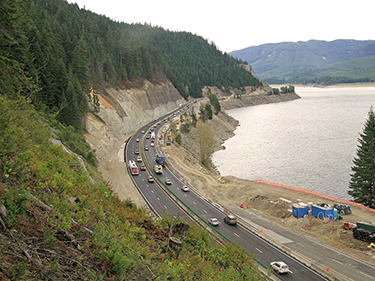|
Subscribe / Renew |
|
|
Contact Us |
|
| ► Subscribe to our Free Weekly Newsletter | |
| home | Welcome, sign in or click here to subscribe. | login |
Construction
| |
November 17, 2014
Prepare for 2 winters without I-90 snowshed
Earlier this year WSDOT removed the 500-foot-long snowshed that has protected the westbound lanes of Interstate 90 at Snoqualmie Pass for 64 years.
The work is part of a $551 million project that is making the freeway wider and safer between Hyak and the Keechelus Dam area.
The snowshed will be replaced by two tall bridges that allow avalanches to pass below them.
But drivers will have to endure two winters without the snowshed before the first bridge is ready.
WSDOT says that will mean longer wait times for drivers as crews do avalanche control.
“The snowshed kept snow out of the westbound lanes and put snow in the eastbound lanes,” said WSDOT regional administrator Don Whitehouse in a release. “Without a snowshed, snow will pile up in both the eastbound and westbound lanes. This means extra work for our maintenance crews and longer delays for drivers.”
To expedite snow removal in avalanche-prone areas, WSDOT took several measures this year:
• installed 540 linear feet of snow nets above the freeway
• dug a 30-foot-wide barrier-lined ditch along the freeway to catch falling snow
• bought two snowmobiles to give crews quicker access to avalanche chutes
WSDOT says the first tall bridge will open for two-way traffic by winter 2016. After the second bridge opens in 2018, traffic will run in one direction on each bridge.
In addition to giving snow nets a try, WSDOT is also testing solar-powered LED lane markers on Snoqualmie Pass.
WSDOT says it's hard to maintain lane markings along the pass due to extreme weather and snow removal equipment, so it installed 4,600 LED markers in October. The markers were epoxied into holes drilled into the pavement.
A WSDOT spokeswoman wrote in an email that LEDs that get direct sunlight are working well, but those in the shade typically last only four hours before going out.
WSDOT will document its findings with the LED markers over the next two years as part of a pilot program. The agency will look at durability and longevity, and how easy the markers are to replace if they stop working.
The five miles of improvements on I-90 are the first phase of a 15.5-mile project to reduce congestion and make the freeway safer.
Max J. Kuney Co. finished the first three miles last year and Guy F. Atkinson Construction is working on the final two miles, including removing the snowshed and building the bridges.
Atkinson crews are working on piers for the first avalanche bridge, but will have to stop when the first snow storm hits. Atkinson's overall work is expected to be finished in fall 2018.
WSDOT is funding Phase 2A, about two miles, with $108 million in savings from the first phase. WSDOT expects to advertise for bids in January and construction will start next spring.
The work also includes the state's first wildlife crossing over a freeway.
Phases 2B and 3, the remaining 8.5 miles, are expected to cost about $390 million. Financing has not been secured.



